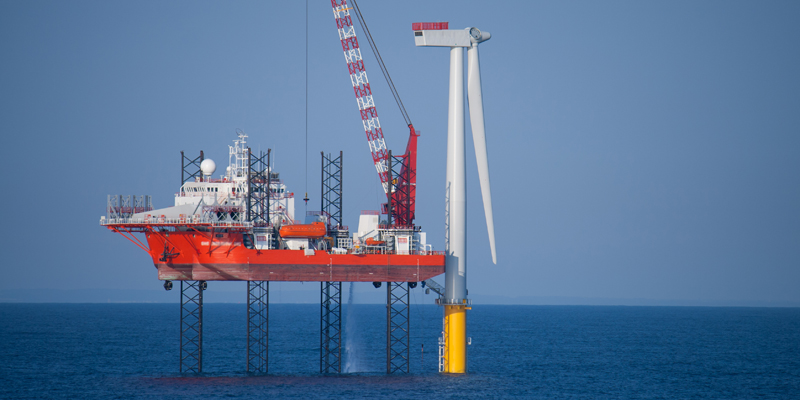Offshore wind power is a decade-long project
The total project development and construction of an offshore wind farm takes about a decade. The permit processes take five to seven years. Construction, which takes two to three years, can begin after the electricity producer's investment decision.

Metsähallitus conducts preliminary surveys in areas that have been identified as suitable for wind power in the maritime spatial plan or regional plan and selects the areas to be developed. In the initial phase, the support of the local municipality is surveyed as it is essential for launching a significant project.
Metsähallitus develops offshore wind power in state-owned areas within the territorial water border. The offshore wind farm area is owned and leased by the state and the planning and construction of the area is regulated by the local municipality.
In the early stages of project development, wind measurements are carried out for approximately two years to provide sufficient information on wind conditions as a basis for the investment. Wind measurements carried out according to certain standards may be preconditions to receiving funding. It is often necessary to rent land from local landowners for wind measurement equipment and masts. The wind measurement equipment is dismantled after the measurements.
The initial assessments also include various central government permits, approval by the Defence Forces, a permit for seabed surveys and a permission to set up an obstacle to air navigation from Traficom under the Aviation Act. The permit processes also include a marine archaeological survey, which is usually carried out at the end of the permit process.
Zoning
The use of the area is determined in urban planning in accordance with the Building Act. Planning forms the basis for obtaining a construction permit. Planning requires approval from the Finnish Defence Forces.
Planning starts with a planning proposal to the local municipality. When the municipality approves the planning proposal, the work can begin. The municipality carries out the planning work that lasts at least for a couple of years and is paid for by the project developer.
Environmental Impact Assessment (EIA)
Planning often proceeds simultaneously with the environmental impact assessment. The EIA procedure is supervised and guided by the ELY Centre.
The EIA procedure examines the project impacts on the local community, nature values, technical matters, and the means to prevent potentially harmful impacts. The surveys required by the EIA procedure are carried out over several snow-free seasons and apply to fish, birds and flora in the area.
Water permit
The offshore wind farm requires a water permit for water construction and activities in water areas. The Regional State Administrative Agency grants the water permit.
The water permit determines the water-related conditions under which a wind farm can be built. At the same time, the necessary monitoring measures concerning the status of water bodies, water quality and fisheries, among other issues, are defined.
As a result of the water permit process, the authorities may impose measures, such as obligatory planting of fish, to compensate for the damage caused to fisheries. Financial compensation for those affected is also possible.
Building permit
The project developer may apply for a building permit once the planning has been completed. The building permit is granted by the municipality in whose area the project is planned.
Power transmission line permit
The electricity produced by the offshore wind turbines is transmitted to the onshore main grid via a submarine cable. The location of the submarine cable is planned with e.g. ship routes and environmental factors in mind. Deep sea areas are also avoided to prevent stress on a hanging submarine cable.
The project developer also prepares for the permit process and construction of the offshore electricity station, the submarine cable and the mainland connection cable. The project developer negotiates with the operator of the power grid and seeks suitable solutions for transmitting the electricity produced by the wind park to the national energy grid.
Investment decision
When the project developer has sufficient certainty about the progress of the permit processes, the developer makes an investment decision.
The technical planning for implementing the project starts much earlier than this. At this point, the company has also started e.g. procurements and logistics planning.
The construction of an offshore wind farm is a major logistical challenge due to the size of the components alone. Parts of wind turbines are mainly transported by sea, in addition to which, the transport of persons and maintenance must be planned.
Construction
Construction takes approximately two to three years and starts with earthworks and foundation. There are several types of foundations. The so-called gravitational foundations and monopiles installed in the seabed are probably best suited to Finnish conditions.
Wind turbines, with usually at least dozens built in offshore wind farms, are assembled as far as possible on the mainland and transported to the construction site. Electricity transmission cables are built between the power plants. If necessary, one or more substations are built at sea.
From the sea, electricity is transmitted to the shore via a cable that is lowered to the bottom of the sea. A substation is built on the mainland, after which the transmission of electricity will continue along an overhead line. The overall locations of the transmission cable and substations are determined in the EIA process. More detailed plans on locations will be included in the building permits and water permit.